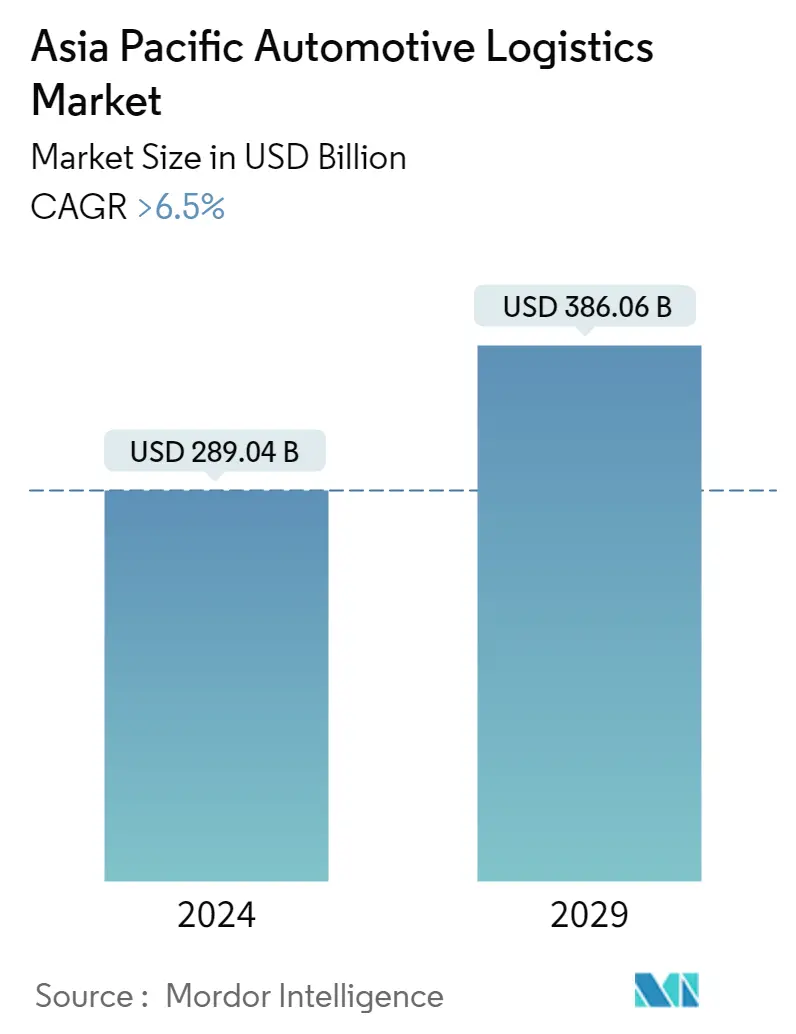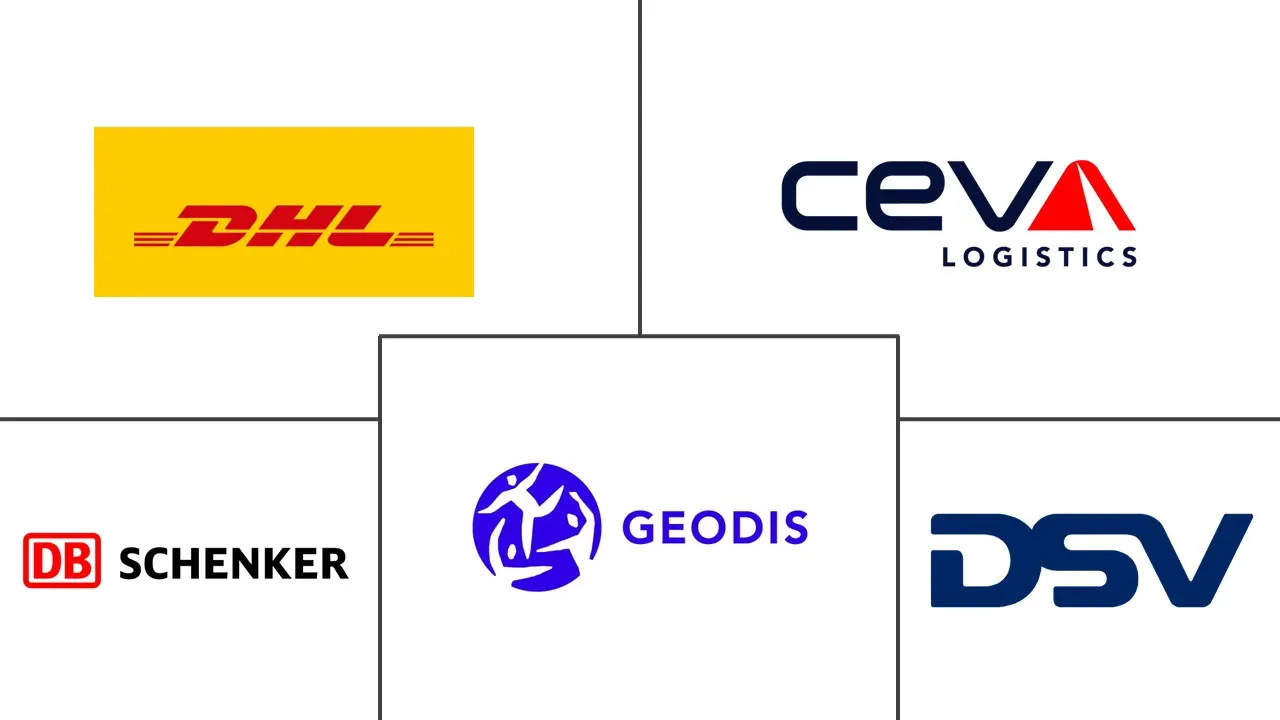Market Size of Asia Pacific Automotive Logistics Industry

| Study Period | 2020 - 2029 |
| Base Year For Estimation | 2023 |
| Market Size (2024) | USD 289.04 Billion |
| Market Size (2029) | USD 386.06 Billion |
| CAGR (2024 - 2029) | 6.50 % |
| Market Concentration | Medium |
Major Players
*Disclaimer: Major Players sorted in no particular order |
Asia Pacific Automotive Logistics Market Analysis
The Asia Pacific Automotive Logistics Market size is estimated at USD 289.04 billion in 2024, and is expected to reach USD 386.06 billion by 2029, growing at a CAGR of greater than 6.5% during the forecast period (2024-2029).
As per the industry analysis, the Asia-Pacific region is estimated to hold the major market share in the global market studied. This is primarily because of the presence of emerging economies like China and India. Numerous factors, like the easy availability of raw materials, increased demand for vehicles in the region, rising population, and availability of low-wage workers, are anticipated to drive the automotive logistics market in the region.
Asia-Pacific is home to some of the major automotive OEM companies, like Toyota, Maruti Suzuki, Hyundai, and SAIC Motor Corporation Limited, among others. With the increasing production and trading activities, there is a demand for logistics companies to manage the procurement, transport, and storage activities of the OEMs to optimize the latter’s supply chain more efficiently.
Global logistics companies are increasingly entering the Asia-Pacific region to tap the growth associated with the market. For instance, in June 2019, French logistics provider GEFCO set up a dedicated subsidiary in Chongqing (China) to specialize in importing and exporting vehicles by rail between Europe, Russia, and China.
Ever-shifting international trade policies, evolving safety and environmental regulations, escalating demand for electronic and autonomous vehicles, changing societal attitudes toward automobiles, global politics, and even cybersecurity issues—all play significant roles in the great auto supply chain.
Various initiatives are undertaken by governmental bodies to accelerate the automotive logistics market further. For instance, in Asia-Pacific, relevant regulations and initiatives to improve professional standards by industry & government play an important role in logistics operations.
The range of logistics services is subject to logistics industry regulations and policies. Moreover, the expansion of such services is also driven by government policies. For instance, the Framework Act on Logistics Policies in Korea provides benefits to companies delivering integrated services of warehousing, transport, and value-added services. The companies entering the automotive logistics market have to comply with multiple entry requirements depending on the type of plan they offer.
Asia Pacific Automotive Logistics Industry Segmentation
Automotive logistics is the meticulous planning and execution of a complicated car transportation process. It covers all modes of transportation, such as rail, truck, and marine.
A complete background analysis of the Asia-Pacific automotive logistics market, which includes an assessment and contribution of the sector in the economy, market overview, market size estimation for key segments, key countries and emerging trends in the market segments, market dynamics, and key component flow statistics are covered in the report. The report also covers the impact of COVID-19 on the market.
The Asia-Pacific automotive logistics market is segmented by service (domestic transportation management, international transport management, warehousing and distribution, value-added services, and others) and by country (India, China, Japan, South Korea, Indonesia, and the Rest of Asia-Pacific).
The report offers the market sizes and forecasts for the Asia-Pacific automotive logistics market in value (USD) for all the above segments.
| By Service | |
| Transportation | |
| Warehousing, Distribution and Inventory Management | |
| Other Services |
| By Type | |
| Finished Vehicle | |
| Auto Components | |
| Other types |
| By Country | |
| China | |
| India | |
| Japan | |
| South Korea | |
| Indonesia | |
| Philippines | |
| Rest of Asia-Pacific |
Asia Pacific Automotive Logistics Market Size Summary
The Asia-Pacific automotive logistics market is poised for significant growth, driven by the region's burgeoning economies such as China and India. These countries are experiencing a surge in vehicle demand, supported by factors like the availability of raw materials, a rising population, and a workforce with competitive wage levels. The presence of major automotive original equipment manufacturers (OEMs) like Toyota, Maruti Suzuki, Hyundai, and SAIC Motor Corporation further fuels the need for efficient logistics solutions to manage procurement, transport, and storage activities. The market is characterized by the entry of global logistics companies seeking to capitalize on the region's growth potential. Additionally, government initiatives and policies, such as Korea's Framework Act on Logistics Policies, are enhancing the logistics landscape by providing regulatory support and incentives for integrated logistics services.
The market's expansion is also influenced by the shift towards electric and autonomous vehicles, with Asia-Pacific leading the global electrified vehicle market. Countries like China, India, Thailand, and Indonesia are implementing policies to boost EV adoption, supported by advancements in battery technology and charging infrastructure. The region is witnessing significant developments in autonomous vehicle technology, with countries like South Korea, China, and Japan experimenting with and legislating for self-driving vehicles. The fragmented nature of the market sees international players like Kuehne+Nagel, C.H. Robinson, and CEVA Logistics dominating the landscape. The ongoing demand for electric vehicles and the strategic initiatives by automotive and logistics companies are expected to drive the market's growth during the forecast period.
Asia Pacific Automotive Logistics Market Size - Table of Contents
-
1. MARKET DYNAMICS
-
1.1 Market Overview
-
1.2 Market Drivers
-
1.2.1 Rising Number of Partnerships among Automobile Manufacturers and Logistics Partners
-
1.2.2 Growth in international trade
-
-
1.3 Market Restraints
-
1.3.1 Nature of Supply Chain Business
-
-
1.4 Market Opportunities
-
1.4.1 Rise in free trade agreements between nations
-
-
1.5 Value Chain / Supply Chain Analysis
-
1.6 Porter's Five Forces Analysis
-
1.6.1 Bargaining Power of Suppliers
-
1.6.2 Bargaining Power of Buyers/Consumers
-
1.6.3 Threat of New Entrants
-
1.6.4 Threat of Substitute Products
-
1.6.5 Intensity of Competitive Rivalry
-
-
1.7 Spotlight - Effect of E-commerce on Traditional Automotive Logistics Supply Chain
-
1.8 Insights on Automotive Aftermarket and its Logistics Activities
-
1.9 Impact of COVID-19 on the market
-
-
2. MARKET SEGMENTATION
-
2.1 By Service
-
2.1.1 Transportation
-
2.1.2 Warehousing, Distribution and Inventory Management
-
2.1.3 Other Services
-
-
2.2 By Type
-
2.2.1 Finished Vehicle
-
2.2.2 Auto Components
-
2.2.3 Other types
-
-
2.3 By Country
-
2.3.1 China
-
2.3.2 India
-
2.3.3 Japan
-
2.3.4 South Korea
-
2.3.5 Indonesia
-
2.3.6 Philippines
-
2.3.7 Rest of Asia-Pacific
-
-
Asia Pacific Automotive Logistics Market Size FAQs
How big is the Asia Pacific Automotive Logistics Market?
The Asia Pacific Automotive Logistics Market size is expected to reach USD 289.04 billion in 2024 and grow at a CAGR of greater than 6.5% to reach USD 386.06 billion by 2029.
What is the current Asia Pacific Automotive Logistics Market size?
In 2024, the Asia Pacific Automotive Logistics Market size is expected to reach USD 289.04 billion.

